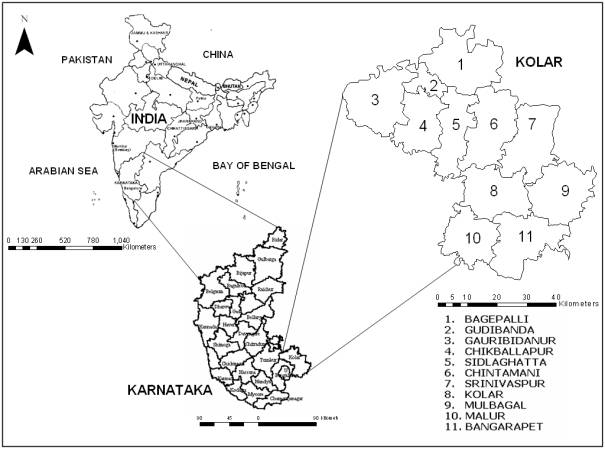
| Back | 2. Data and Study Area |
Band 1 to band 36 MODIS data “MOD 02 Level-1B Calibrated Geolocation Data Set” were downloaded from EOS Data Gateway [7]. This Level 1B data set contains calibrated and geolocated at-aperture radiances for 36 bands generated from MODIS Level 1A sensor counts (MOD 01). This data product [8], contains the radiometrically corrected, fully calibrated and geolocated radiances at-aperture for all spectral bands at 1km resolution [9]. Band 1 to band 7 MODIS product known as “MOD 09 Surface Reflectance 8-day L3 global” at 250 (band 1 and band 2) and 500m (band 1 to band 7) were also downloaded. The MOD 09 product is computed from the MODIS Level 1B land bands 1, 2, 3, 4, 5, 6, and 7 (centred at 648 nm, 858 nm, 470 nm, 555 nm, 1240 nm, 1640 nm, and 2130 nm, respectively) which is an estimate of the surface spectral reflectance for each band as it would have been measured at ground level if there were no atmospheric scattering or absorption [10]. These data are broken into granules approximately 5-min long and stored in Hierarchical Data Format (HDF).
The Indian Remote Sensing Satellites IRS - 1C/1D LISS 3 (Linear Imaging Self-Scanning Sensor 3) MSS (Multi Spectral Scanner) data having bands in Green, Red and Near-infrared part of the electromagnetic spectrum with a spatial resolution of 23.5 m procured from NRSA, Hyderabad was used as the high resolution image.
Kolar district in Karnataka State, India, chosen for this study is located in the southern plain regions (semi arid agro-climatic zone) extending over an area of 8238.47 sq. km. between 77°21' to 78°35' E and 12°46' to 13°58' N (Figure 1).
Kolar is divided into 11 taluks (or administrative boundaries/blocks/units) for administration purposes (taluks are Bagepalli, Bangarpet, Chikballapur, Chintamani, Gudibanda, Gauribidanur, Kolar, Malur, Mulbagal, Sidlaghatta and Srinivaspur). The distribution of rainfall is during southwest and northeast monsoon seasons. The average population density of the district is about 2.09 persons/hectare. The district is devoid of significant perennial surface water resources. The groundwater potential is also assessed to be limited. The terrain has a high runoff due to less vegetation cover contributing to erosion of top productive soil layer leading to poor crop yield. Out of about 280 thousand hectares of land under cultivation, 35% is under well and tank irrigation [11].